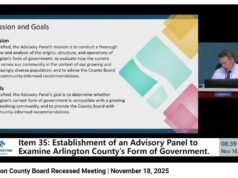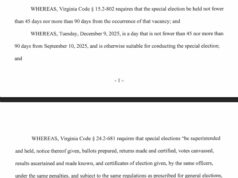With the proposed Potomac Yard Wizards/Caps arena now dead, there’s a lot of finger pointing and analysis going on by people who wanted the arena, opposed the arena (e.g., Sen. Louise Lucas, Alexandria citizen activists), would have built the arena, etc. Not surprisingly, Alexandria Mayor Justin Wilson – who was at the center of the effort to bring the arena to his city – has a lot of thoughts on how this all went down. See his monthly newsletter and below for what he has to say, including:
- “With a new 20-year lease within the existing shopping center now taking effect with the death of this proposal, very little will likely change in much of North Potomac Yard for quite some time. While there are developable properties on the site, they will be constrained by the persistence of the shopping center and its large surface parking lot. This will also significantly delay the City’s receipt of important proffers required with development, most importantly a new school.”
- “The City was never able to bring a formal, fully-formed proposal to the community for its consideration. To do so, required General Assembly action. Ultimately, the Senate of Virginia never held a vote on the legislation adopted by the House of Delegates, nor was the proposal included in the budget adopted by the General Assembly.”
- “While this proposal is gone, all Virginians should be wary of economic development proposals becoming just another vehicle for partisan warfare”
- “There were legitimate concerns raised in Alexandria and Richmond about this proposal. Those concerns enriched the discussion and the creativity of the proposal as it began to evolve. At the same time, there were things that occurred during this process that pushed the limits of what is appropriate.“
- “If we simply gave up on considering any worthy initiative at the first sign of adversity, we would not have a Potomac Yard Metro Station, a Virginia Tech Innovation Campus, a redeveloped waterfront, new schools, new sewer infrastructure, a redeveloping Landmark Mall, etc. Big, transformational projects are difficult. They require negotiation, collaboration and concessions. Unfortunately, there was never a productive collaboration between the Governor and the General Assembly leadership to work through the concerns raised during this process.”
- “The fact that this partisan warfare ended a potential economic development initiative before it could be considered fully, is unfortunate. The fact that this happened while the General Assembly considers another budget that places over 80% of the cost of Alexandria schools on the backs of Alexandria taxpayers, while systematically underfunding state services so that local governments must pick up the tab, is particularly galling.”
- “With this proposal now dead and the shopping center likely to remain for the foreseeable future, we must now pursue large-scale economic growth elsewhere in the City, pursue greater austerity in the provision of City services or prepare taxpayers for a more significant burden in the future.”
| Potomac Yard Proposal Concludes |
| In my installation speech when I was first sworn in as Mayor over 5 years ago, I talked about the intersection of policy decisions and the municipal services they support: “A development decision is also a decision about public safety, about schools, and about human services, because that is what it supports.”
If my words at the beginning of my tenure as Mayor were correct, the announcement of the end of Entertainment District proposal for Potomac Yard last week, near the end of my tenure, was perhaps the most negative financial event for our schools, public safety and human services in recent history. Regardless of your perspective on the North Potomac Yard proposal, it held the potential to dramatically reshape Alexandria’s economy, easing the burden on our residential taxpayers and enabling expanded investment in critical services to our residents, as well as yielding new land for a school, open space and committed affordable housing. A month ago, Alexandria’s Finance staff provided the most detailed view yet of the estimated financial impact on the City’s budget. The net return to the City’s balance sheet was projected to be cash flow positive in the first year and continue to appreciate, leading to a $490 impact (either tax decrease or service increase) for the average Alexandria household after only the first phase. But that is now in the past, as this proposal, and the economic potential it represented, will remain unrealized. With a new 20-year lease within the existing shopping center now taking effect with the death of this proposal, very little will likely change in much of North Potomac Yard for quite some time. While there are developable properties on the site, they will be constrained by the persistence of the shopping center and its large surface parking lot. This will also significantly delay the City’s receipt of important proffers required with development, most importantly a new school. Since the December economic development announcement for North Potomac Yard, a lot has happened. There will be much to unpack about our experience over the past 3.5 months of public consideration of this proposal. The City (myself included!), the Governor, the General Assembly, Monumental Sports and Entertainment and JBG all made significant mistakes during this process. We’ll all take lessons from the experience. The City was never able to bring a formal, fully-formed proposal to the community for its consideration. To do so, required General Assembly action. Ultimately, the Senate of Virginia never held a vote on the legislation adopted by the House of Delegates, nor was the proposal included in the budget adopted by the General Assembly. Economic growth in Virginia has enjoyed bipartisan support, particularly during eras of divided government in Richmond. While this proposal is gone, all Virginians should be wary of economic development proposals becoming just another vehicle for partisan warfare. The high quality of life that Virginians enjoy with relatively low taxation is the product of that bipartisan work. There were legitimate concerns raised in Alexandria and Richmond about this proposal. Those concerns enriched the discussion and the creativity of the proposal as it began to evolve. At the same time, there were things that occurred during this process that pushed the limits of what is appropriate. If we simply gave up on considering any worthy initiative at the first sign of adversity, we would not have a Potomac Yard Metro Station, a Virginia Tech Innovation Campus, a redeveloped waterfront, new schools, new sewer infrastructure, a redeveloping Landmark Mall, etc. Big, transformational projects are difficult. They require negotiation, collaboration and concessions. Unfortunately, there was never a productive collaboration between the Governor and the General Assembly leadership to work through the concerns raised during this process. The fact that this partisan warfare ended a potential economic development initiative before it could be considered fully, is unfortunate. The fact that this happened while the General Assembly considers another budget that places over 80% of the cost of Alexandria schools on the backs of Alexandria taxpayers, while systematically underfunding state services so that local governments must pick up the tab, is particularly galling. But to understand why this proposal was on the table in the first place requires a step back a bit.
A little over 62% of that money will be raised from the real estate tax. Twenty years ago, 51.5% of our budget was funded by the real estate tax. By digging a little deeper, the story becomes even more stark. Two decades ago, 69.6% of our real estate tax revenue came from residential sources, either residential taxpayers or the owners of residential multi-family buildings. Today nearly 81% of real estate tax revenues come from those sources, with only 19% coming from our commercial tax base. As a contrast, while our friends in Arlington have faced some of the same factors, their commercial tax base is 23% of their total tax base, which has led to Arlington having the lowest real estate tax rate of any major jurisdiction in the region. In Fairfax County, their commercial tax base is now just a little over 16% of their overall base. What happened? The short answer: A lot of things:
That leaves us in a place where today residents of Alexandria are footing a larger percentage of the cost of their government than they ever have. The trajectory that we have seen over the past two decades shows no sign of abating in the future. The only true way to change this trajectory is through economic development. Alexandria has had some successes:
That Metro Station is a key component of a larger vision for a mixed-use North Potomac Yard. For decades, City plans have assumed that over time, the existing shopping center and its acres of surface parking, would give way to a new mixed-use neighborhood, with residential, commercial, entertainment, a school, park land and much more. The North Potomac Yard Plan, includes the area north of East Glebe Road continuing to the City border, and allows over 7.6 million square feet of development. Much has changed since those plans were originally approved. New office development was on life support before the pandemic. In a post-pandemic world, there is essentially zero new office development occurring in the DC region. Existing office portfolios are defaulting at an alarming rate as tenants decide not to renew their leases. The economic growth of our region’s future will be experiential, the types of non-residential uses that cannot be virtualized. With this proposal now dead and the shopping center likely to remain for the foreseeable future, we must now pursue large-scale economic growth elsewhere in the City, pursue greater austerity in the provision of City services or prepare taxpayers for a more significant burden in the future. Those are challenges that future City Councils will grapple with along with Alexandria residents. I am appreciative of the dedicated work of our Alexandria Economic Development Partnership (AEDP) team and our City staff from so many different agencies who worked to present this concept to the public. I am also appreciative of the detailed engagement by residents of our community throughout this process. |













![Video: Sen. Tim Kaine on “Meet the Press” Says DoJ Not Complying with the Law on Release of ALL the Epstein Files, But Argues “I think [impeachment/contempt for DoJ officials is] premature”](https://bluevirginia.us/wp-content/uploads/2025/12/kainemtp1221-100x75.jpg)

![Video: Rep. James Walkinshaw (D-VA11) Says “It’s enormously frustrating,” as “the law is clear…the full files were supposed to be released [yesterday] and the Trump administration is not in compliance with that law”](https://bluevirginia.us/wp-content/uploads/2025/12/walk1219-100x75.jpg)